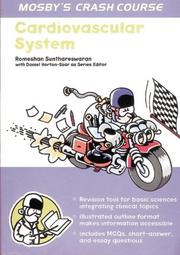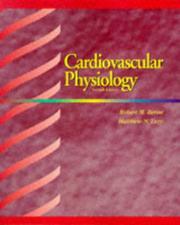| Listing 1 - 10 of 3828 | << page >> |
Sort by
|
Book
ISBN: 9782876714984 2876714981 Year: 2006 Publisher: Paris: Frison-Roche,
Abstract | Keywords | Export | Availability | Bookmark
 Loading...
Loading...Choose an application
- Reference Manager
- EndNote
- RefWorks (Direct export to RefWorks)
Book
Year: 2015 Publisher: Bruxelles: UCL. Faculté de pharmacie et des sciences biomédicales,
Abstract | Keywords | Export | Availability | Bookmark
 Loading...
Loading...Choose an application
- Reference Manager
- EndNote
- RefWorks (Direct export to RefWorks)
Cardiovascular diseases are aongst the main causes of death for several decades bur still the available treatments are not a panacea. Hence the ivabradine constitutes a new approach by decreasing the heart rate on a selective basis. The mode of action of this molecule is based on the inhibition of the HCN channels. The channels are involved in the regulation of the sinoauricular node activity which gives them a major influence on the heart rate whithout modifying the force of contraction. Besides, thanks to its chronotrop negative selective effect, the ivabradine could constitute an interesting therapeutic solution for the treatment of cardiac failure or stable angina. However, this molecule carries some side effects such as an excessive bradycardia , a risk of AV-block or the emergence of phrosphenes. Regarding its effenciency, the scope of studies available is currently limited to studies of non inferiority trials of first line treatments and, even though, those trials had been concluding, the ivabradine has only a small place in the current therapeutic arsenal. However, those features enable the ivabradine to be an important medicine in the first against chronic cardiac failure and stable angina when the first choice medicines cannot be considered like in the following cases : 1) In the case of CHF from NYHA II and IV functional class with systolic dysfunction, for a patient which is in sinus rhythm and with a heart rate higher or equal to 75 bpm and an ejection fraction less than 35%, by joining to standard treatment with ß-blokings, or in the case of contrainindications or intolerances to ß-blokings. 2) In the case of chronic stable angina in adults coronary with a sinus rhythm, presenting intolerances or a contraindication to ß-blokings, or by joing with ß-blokings for patients insufficiently controlled by an optimal dose of ß-blokings and for which the cardiac frequency remains higher than 60 bpm. Furthermore, the ivabradine coverage criteria had been recently strengthened and the European Medicine Agency (EMA) pharmacovigilance committee decided to reevaluate the benefit/risk balance of this medicine which confirms the small but important role of this molecule and implies to use it whith cautious and in some limited cases. Bien que les maladies cardiovasculaires fassent parties des principales causes de décès depuis plusieurs décennies, les traitements disponibles ne constituent pas une panacée.L'ivabradine présente une nouvelle approche en réduisant la fréquence cardiaque de manière sélective. Le mécanisme d'action de cette molécule se base sur l'inhibition des canaux HCN, canaux impliqués dans la régulation de l 'activité du nœud sino-auriculaire ce qui leur donne une influence majeure dans le rythme cardiaque sans modifier la force de contraction. De par son effet chronotrope négatif sélectif, l'ivabradine pourrait constituer une solution thérapeutique intéressante dans le cadre du traitement de l'insuffisance cardiaque ou de l'angor stable. Cette molécule n'est cependant pas dépourvue d'effets indésirables tels la bradycard ie excessive, le risque de bloc auriculo-ventriculaire et l'apparition de phosphènes. En ce qui concerne son efficacité, il n'existe à ce jour, que des études de non infériorité par rapports aux traitements de première ligne. Si ces essais ont été concluants, il ne donne pourtant à l 'ivabradine qu'une petite place dans l'arsenal thérapeutique. Son apport est pourtant d'une grande importance dans le traitement de l'insuffisance cardiaque chronique et l'angor stable quand les médicaments de premiers choix ne sont pas envisageables : I ) Dans le cas de l'ICC de classe NYHA II à IV avec dysfonction systolique, chez un patient en rythme sinusal dont la fréquence cardiaque est supérieure ou égale à 75 bpm et une fraction d'éjection < que 35%, en association au traitement standard comprenant les P-bloquants, ou en cas de contre-indication ou d'intolérance aux P-bloquants. 2) Dans le cas de l'angor stable chronique chez l'adulte coronarien en rythme sinusal, présentant une intolérance ou une contre-indication aux P-bloquants, ou en association aux P-bloquants chez des patients insuffisamment contrôlés par une dose optimale de P bloquants, et dont la fréquence cardiaque reste supérieure à 60 bpm. Récemment, les critères de remboursement de l'ivabradine ont été renforcés et le comité de pharmacovigilence de l'agence européenne des médicaments (EMA) a décidé de réévaluer la balance bénéfice/risque de ce médicament, ce qui confirme la place restreinte mais non négligeable de cette molécule et mène à n'utiliser cette molécule qu'avec prudence, dans certains cas bien précis.
Book
ISBN: 2742006788 9782742006786 Year: 2008 Publisher: Montrouge: John Libbey eurotext,
Abstract | Keywords | Export | Availability | Bookmark
 Loading...
Loading...Choose an application
- Reference Manager
- EndNote
- RefWorks (Direct export to RefWorks)

ISBN: 0723429928 9780723429920 Year: 1998 Publisher: London: Mosby,
Abstract | Keywords | Export | Availability | Bookmark
 Loading...
Loading...Choose an application
- Reference Manager
- EndNote
- RefWorks (Direct export to RefWorks)

ISBN: 0815109016 9780815109013 Year: 1997 Publisher: Saint Louis: Mosby,
Abstract | Keywords | Export | Availability | Bookmark
 Loading...
Loading...Choose an application
- Reference Manager
- EndNote
- RefWorks (Direct export to RefWorks)
Multi
ISBN: 9780323568432 0323568432 9780323568449 0323568440 9780323533669 0323533663 Year: 2019 Publisher: Philadelphia, PA : Elsevier, Inc.,
Abstract | Keywords | Export | Availability | Bookmark
 Loading...
Loading...Choose an application
- Reference Manager
- EndNote
- RefWorks (Direct export to RefWorks)
"Dr. Richard Polin's Neonatology Questions and Controversies series highlights the most challenging aspects of neonatal care, offering trustworthy guidance on up-to-date diagnostic and treatment options in the field. In each volume, renowned experts address the clinical problems of greatest concern to today's practitioners, helping you handle difficult practice issues and provide optimal, evidence-based care to every patient. "--Publisher's description
Book
Year: 1935 Publisher: Paris : Masson et cie, éditeurs,
Abstract | Keywords | Export | Availability | Bookmark
 Loading...
Loading...Choose an application
- Reference Manager
- EndNote
- RefWorks (Direct export to RefWorks)
Book
ISBN: 9780198717027 Year: 2016 Publisher: New York, NY : Oxford University Press,
Abstract | Keywords | Export | Availability | Bookmark
 Loading...
Loading...Choose an application
- Reference Manager
- EndNote
- RefWorks (Direct export to RefWorks)
Periodical
Year: 2021 Publisher: [Seoul] : Korean Society for Thoracic and Cardiovascular Surgery,
Abstract | Keywords | Export | Availability | Bookmark
 Loading...
Loading...Choose an application
- Reference Manager
- EndNote
- RefWorks (Direct export to RefWorks)
Book
ISBN: 9535121693 9535172565 Year: 2015 Publisher: IntechOpen
Abstract | Keywords | Export | Availability | Bookmark
 Loading...
Loading...Choose an application
- Reference Manager
- EndNote
- RefWorks (Direct export to RefWorks)
This book is aimed to accentuate the importance of hypercholesterolemia, since targeting and treating the hypercholesterolemia is increasingly well known as an essential strategy in the prevention of atherosclerosis-induced cardiovascular disease. It is important to look at hypercholesterolemia as it is proved to be crucial as well as the early stage of atherogenesis and can also be managed with appropriate treatment. This book describes the basics of hypercholesterolemia and its causes and various experimental animal models to understand and study the pathophysiology of hypercholesterolemia as well as to present practice-based clinical approaches to treat hypercholesterolemia. Further, the book describes various treatment strategies of hypercholesterolemia in detail, especially the appropriate use of statin. It is well known that the use of statin is an ideal as well as a potent therapy to lower cholesterol level and also has various beneficial pharmacological effects to prevent cardiovascular diseases. However, there exists less awareness about the use of statin. Hence, it is important to understand the appropriate use of statin in terms of doses for different stages of hypercholesterolemia, side effects, resistance of its use, and also interaction of statin with other drugs, which are well described in this book. In short, the major aim of this compendium is to present to the readers comprehensive, updated, and current research perspectives on hypercholesterolemia.
Cardiovascular Diseases. --- Cardiovascular diseases --- Cardiovascular medicine
| Listing 1 - 10 of 3828 | << page >> |
Sort by
|

 Search
Search Feedback
Feedback About UniCat
About UniCat  Help
Help News
News